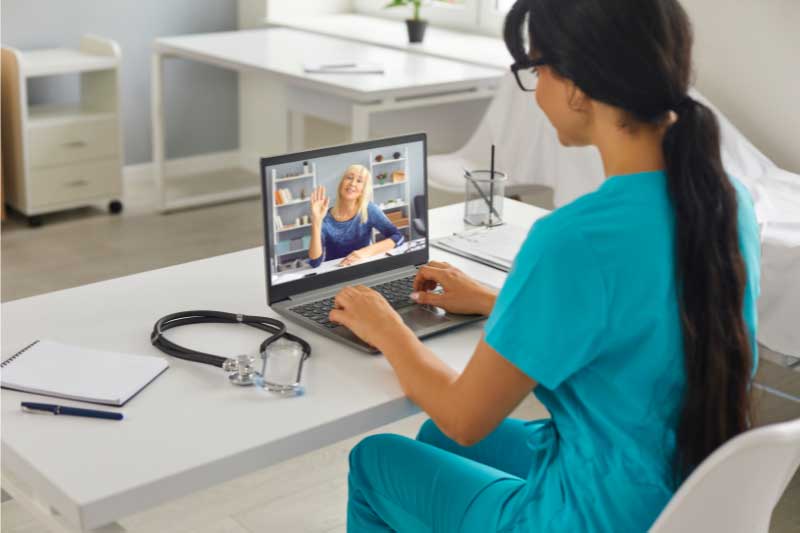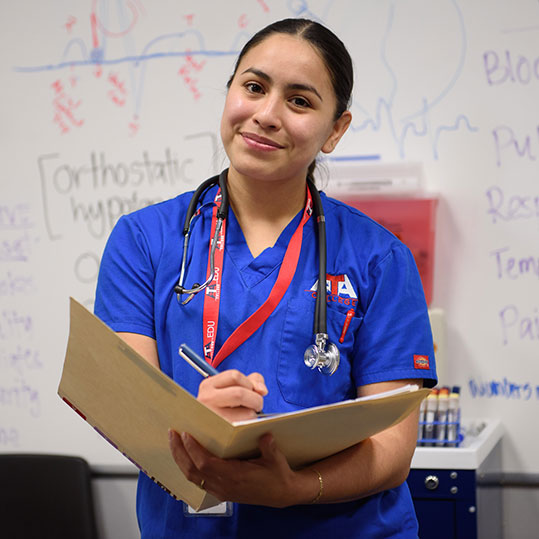The healthcare landscape has undergone a dramatic transformation, with telehealth emerging as a cornerstone of modern medical practice. As virtual consultations become increasingly common, medical assistants find themselves at the forefront of this digital revolution, adapting their skills to meet the evolving needs of patients and healthcare providers.
Medical assistants have always served as the backbone of healthcare delivery, bridging the gap between patients and physicians. Now, their role extends beyond traditional clinical settings into the virtual realm, where they facilitate remote consultations, manage digital workflows, and ensure seamless patient experiences across multiple platforms.
This shift represents more than just a technological upgrade—it’s a fundamental reimagining of how healthcare support professionals contribute to patient care. For medical assistants looking to advance their careers and healthcare organizations seeking to optimize their telehealth services, understanding these new responsibilities and required skills has become essential.
The expansion of telehealth services has created unprecedented opportunities for medical assistants to demonstrate their adaptability and value within healthcare teams. By embracing digital tools and developing new competencies, they’re not just keeping pace with change—they’re helping to shape the future of healthcare delivery.
The Evolution of Medical Assistant Responsibilities
Traditional Duties Meet Digital Demands
Medical assistants traditionally managed appointment scheduling, patient intake, vital signs collection, and administrative tasks within physical healthcare facilities. These core responsibilities remain important, but telehealth has expanded their scope significantly.
Remote patient monitoring has become a key area where medical assistants excel. They now coordinate with patients to set up home monitoring devices, explain proper usage techniques, and collect data for physician review. This involves teaching patients how to use blood pressure cuffs, pulse oximeters, and glucometers while ensuring accurate readings are transmitted to healthcare providers.
Patient education has evolved from face-to-face demonstrations to creating digital resources and conducting virtual training sessions. Medical assistants develop instructional videos, write clear procedural guides, and conduct one-on-one technology tutorials to help patients navigate telehealth platforms successfully.
Administrative Coordination in Virtual Settings
The complexity of managing both in-person and virtual appointments requires sophisticated organizational skills. Medical assistants now juggle multiple scheduling systems, coordinate technology requirements for different types of consultations, and ensure patients receive proper preparation instructions for their virtual visits.
Insurance verification and prior authorization processes have become increasingly complex with the introduction of telehealth services. Medical assistants must understand the variations in coverage for different types of virtual consultations and help patients navigate potential cost differences between in-person and remote care options.
Documentation requirements have expanded to include technology troubleshooting notes, patient digital literacy assessments, and detailed records of remote monitoring compliance. These additions require medical assistants to develop new documentation skills while maintaining accuracy and completeness in patient records.
Essential Technology Skills for Modern Medical Assistants
Platform Proficiency and Technical Support
Mastering multiple telehealth platforms has become fundamental for medical assistants working in digital healthcare environments. Each platform offers unique features, security protocols, and user interfaces that require dedicated learning time and ongoing skill development.
Video conferencing technology extends beyond basic call management. Medical assistants learn to optimize audio and video quality, manage screen sharing for educational purposes, and troubleshoot common connectivity issues that might disrupt patient consultations.
Electronic health record integration with telehealth systems requires understanding how virtual visit data flows into existing documentation systems. Medical assistants ensure continuity between remote and in-person care by maintaining comprehensive digital records that support coordinated treatment plans and facilitate seamless communication.
Digital Communication and Patient Support
Written communication skills have gained increased importance as medical assistants frequently interact with patients through secure messaging systems, email platforms, and patient portals.
Clear, professional written communication helps prevent misunderstandings and provides patients with reliable reference materials.
Technical troubleshooting capabilities enable medical assistants to guide patients through common technology challenges. This includes helping patients test their devices before appointments, explaining how to adjust camera angles for optimal consultation experiences, and providing alternative solutions when primary platforms encounter difficulties.
Patient portal management involves teaching patients how to access test results, schedule appointments, request prescription refills, and communicate with healthcare teams through secure digital channels. Medical assistants often serve as the primary point of contact for patients learning to navigate these systems.
Enhancing Patient Experience Through Digital Channels
Pre-Visit Preparation and Education
Successful telehealth consultations require thorough preparation that begins well before the scheduled appointment time. Medical assistants contact patients in advance to review technology requirements, conduct test connections, and provide detailed instructions for accessing virtual consultation platforms.
Patient education materials have evolved to include digital resources such as instructional videos, downloadable guides, and interactive tutorials. Medical assistants curate these resources based on individual patient needs, ensuring that people with varying levels of technology comfort can participate successfully in telehealth services.
Environmental preparation guidance helps patients create optimal spaces for virtual consultations. Medical assistants advise patients on lighting requirements, background considerations, privacy measures, and positioning strategies that enhance communication quality during remote appointments.
Post-Visit Follow-Up and Care Coordination
Follow-up communication after telehealth visits often requires more extensive coordination than traditional in-person appointments. Medical assistants schedule additional virtual check-ins, coordinate prescription deliveries, and arrange for any necessary in-person follow-up appointments.
Care plan communication involves explaining treatment recommendations, medication changes, and lifestyle modifications through digital channels. Medical assistants ensure patients understand their care plans by providing written summaries, scheduling follow-up calls, and connecting patients with additional educational resources.
Outcome monitoring requires medical assistants to track patient progress through the use of remote monitoring devices, patient-reported outcomes, and scheduled check-in calls. This ongoing engagement helps identify potential issues early and ensures continuity of care between virtual visits.
Training and Professional Development Opportunities
Certification and Continuing Education
Professional development in telehealth requires medical assistants to pursue specialized training programs that cover digital health technologies, remote patient monitoring, and virtual care coordination. Many professional organizations now offer telehealth-specific certification programs that validate these emerging skills.
Continuing education opportunities include webinars, online courses, and virtual conferences focused on digital health innovations. Medical assistants benefit from staying current with technology trends, regulatory changes, and best practices in virtual care delivery.
Cross-training in multiple telehealth platforms increases versatility and career opportunities. Medical assistants who can work effectively across different systems become valuable assets to healthcare organizations implementing diverse digital health solutions.
Soft Skills Development for Digital Environments
Effective communication skills are essential in virtual environments, where non-verbal cues may be limited and technical barriers can significantly impact interactions. Medical assistants develop strategies for building rapport through digital channels and maintaining empathetic connections with patients they may never meet in person.
Problem-solving abilities become crucial when technical issues arise during patient consultations. Medical assistants learn to think quickly, provide alternative solutions, and maintain a calm, professional demeanor while resolving technology-related challenges.
Cultural competency in digital health involves understanding how different patient populations interact with technology and adapting communication strategies accordingly. This includes recognizing variations in digital literacy and providing appropriate levels of technical support.
Challenges and Solutions in Telehealth Implementation
Technology Barriers and Patient Support
Digital divide issues affect many patients who lack reliable internet access, suitable devices, or the necessary technical skills for telehealth participation. Medical assistants develop strategies to identify at-risk patients and coordinate alternative care delivery methods when virtual consultations aren’t feasible.
Device compatibility challenges require medical assistants to understand the capabilities and limitations of various smartphones, tablets, and computers commonly used by patients. This knowledge helps them provide targeted technical support and recommend solutions for optimal telehealth experiences.
Privacy and security concerns must be addressed through patient education about HIPAA-compliant platforms, secure communication practices, and appropriate virtual consultation environments. Medical assistants play key roles in ensuring patients understand their responsibilities for maintaining confidentiality during remote healthcare interactions.
Workflow Integration and Efficiency
Hybrid care models that combine in-person and virtual services require sophisticated scheduling and coordination systems. Medical assistants develop expertise in managing complex calendars that accommodate both traditional appointments and virtual consultations while optimizing provider availability and patient convenience.
Documentation workflows must seamlessly integrate information from virtual visits with existing electronic health records. Medical assistants ensure continuity by developing standardized processes for capturing and organizing telehealth-specific information within established documentation systems.
Quality assurance processes help maintain high standards of care across both virtual and in-person services. Medical assistants participate in ongoing quality improvement initiatives by collecting patient feedback, identifying process inefficiencies, and suggesting improvements to telehealth workflows.
Future Outlook for Medical Assistants in Digital Healthcare
Emerging Technologies and Opportunities
The integration of artificial intelligence will create new opportunities for medical assistants to work alongside intelligent systems that can automate routine tasks, analyze patient data, and provide decision-support tools.
Understanding how to collaborate effectively with AI technologies will become an important skill set.
Remote monitoring technologies continue to evolve, creating opportunities for medical assistants to specialize in chronic disease management, post-surgical recovery support, and preventive care coordination through digital health tools.
Mobile health applications offer expanding roles for medical assistants in patient engagement, medication adherence monitoring, and lifestyle modification support. These platforms create new touchpoints for ongoing patient relationships beyond traditional appointment-based interactions.
Career Advancement and Specialization
Telehealth specialization creates distinct career pathways for medical assistants who develop expertise in virtual care delivery, remote patient monitoring, and digital health technologies. These specialized skills command higher compensation and increased responsibility within healthcare organizations.
Leadership opportunities emerge as healthcare organizations expand their telehealth capabilities and need experienced medical assistants to train colleagues, develop protocols, and manage virtual care programs.
Cross-functional collaboration increases as medical assistants work more closely with IT departments, quality improvement teams, and administrative leaders to optimize telehealth operations and patient experiences.
Embracing the Digital Healthcare Future
The integration of medical assistants into telehealth represents a natural evolution of their essential role in healthcare delivery. Those who embrace digital technologies and develop relevant skills position themselves for continued career growth and increased job satisfaction.
Healthcare organizations benefit tremendously from medical assistants who can effectively bridge the gap between traditional patient care and emerging digital health solutions. Their unique combination of clinical knowledge, administrative skills, and patient interaction expertise makes them invaluable assets in hybrid care environments.
Success in this evolving landscape requires commitment to ongoing learning, adaptability to new technologies, and dedication to maintaining the human connection that remains central to quality healthcare delivery. Medical assistants who cultivate these qualities will continue to play vital roles in shaping the future of healthcare.
The transformation of healthcare through digital technologies creates unprecedented opportunities for medical assistants to expand their impact, develop new expertise, and contribute meaningfully to improved patient outcomes. By embracing these changes and developing relevant skills, they ensure their continued relevance and value in an increasingly digital healthcare ecosystem.





